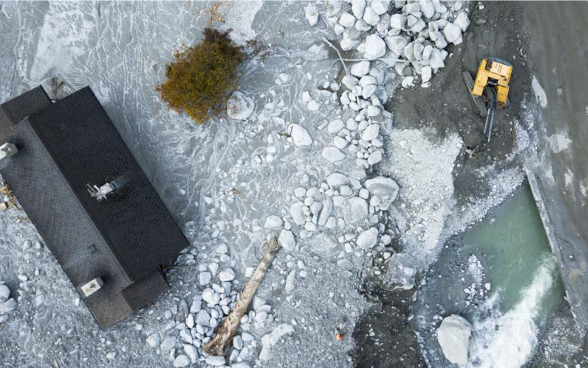New challenges are emerging in Switzerland as climate change, urban development and land use densification increase the risks due to natural hazards. To remain adaptable, we need to be able to detect changes and developments at an early stage.

© Keystone, G. Ehrenzeller
Switzerland has a long tradition concerning fundamental research as well as practice- and implementation-oriented research in hazard prevention and there are an important number of research institutions active in this domain. The findings of these research activities will further improve the management of natural hazards and the risks of events, taking into account environmental aspects, climate change and settlement densification. The Research Master Plan ENVIRONMENT (in German and French) describes the implementation of environmental policies in 18 research areas and thus the priority fields of research from the perspective of the Federal Office For The Environment in the near and future term. FOEN’s priority themes in hazard prevention for 2021 – 2024 are listed below.
Research priorities in hazard prevention 2021 – 2024 (gravitational natural hazards)
- Know hazards and risks comprehensively
1.1 Generation of basic scientific knowledge for hazard processes like e.g. lateral erosion of watercourses, hillslope debris flows, rockfall, snow gliding avalanches, and impulse waves in Swiss lakes triggered by mass movements or earthquakes (tsunamis on lake shores) and of the influence of climate change on such processes
1.2 Development of methods to record natural hazard processes, e.g. sediment and driftwood transport, to register indirect damages due to natural hazard events and development of methods to assess future hazards and extreme events due to climate change. A good example for this topic is the recently completed WoodFlow research project, which improves the understanding of the processes governing large wood dynamics in watercourses and provides practitioners with suitable tools to help assess and manage large wood-related hazards.
1.3 Development of a methodology for risk overviews at different spatial scales
1.4 Investigation of the impact of climate change on the risk landscape in Switzerland and analysis of combinations and concatenations of different processes
1.5 Elaboration of fundamentals to quantify the vulnerability and the risk for infrastructural systems in the event of earthquakes and gravitational natural hazards
- Identify events at an early stage
2.1 Investigation of precipitation thresholds and analysis of the disposition to slope processes in depth. The FOEN is currently developing a warning system for landslides and hillslope debris flows. These disposition warnings provide indications at various warning levels as to the areas and probability of slopes becoming unstable due to the current water saturation. The monitoring of landslide areas is also being intensified. With the InSAR (satellite-based radar interferometry) method, it is possible to monitor mass movements in the Alpine region and to detect new movements.
2.2 Improvement of extreme value statistics
2.3 Improvement of the forecasting and early detection of natural hazards
- Plan measures integrated and to be robust
3.1 Development of methods for evaluating options for action within the integrated risk management
3.2 Development of new instruments for risk-based land use and their practical implementation in spatial planning
3.3 Analysis of ecological aspects in the implementation of protective measures and addressing of the dichotomy of the protective function of the forest vs the forest as a habitat for game animals. The new research program River Engineering and Ecology is a good example for this topic. It aims to develop scientific foundations for answering current practical questions in river management (flood protection and renaturation of water bodies) and for preparing outreach products for knowledge transfer.
3.4 Development of methods to assess existing protective structures and to assess robust protective systems; development of models for dynamic loads on structures
- Search the risk dialogue and observe the impact on society
4.1 Investigation of the social science component in risk perception and communication; conduction of research into the acceptance of measures
4.2 Further development of cost-benefit analysis in integrated risk management; development of methods for quantifying the indirect economic damage after earthquakes and gravitational natural hazards
4.3 Integration of organisational and human factors in risk identification and assessment
Continuing education
Below you will find a compilation of Switzerland-wide offers for cotinuing education in the field of natural hazards.
Further information
Last modification 24.03.2022





